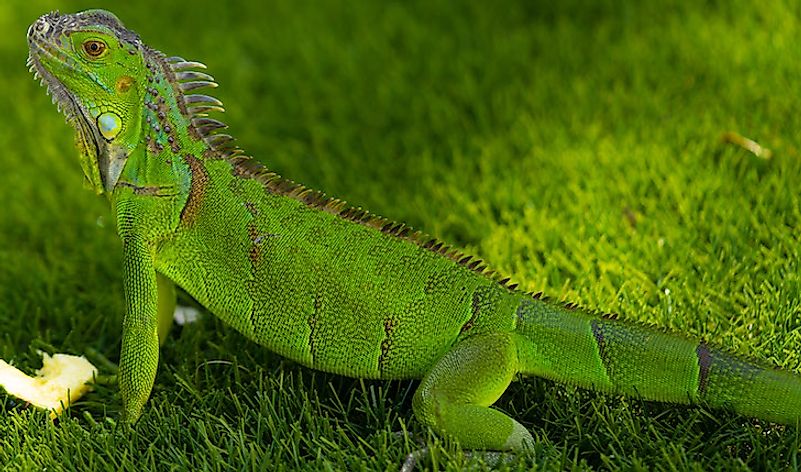Where Do Green Iguanas Live?

The green iguana is also known as the Common iguana or American iguana. Green iguanas are native to areas such as South and Central America, as well as in the Caribbean and islands in the West Indies. They also roam the landscapes of countries like Brazil, Paraguay, and Mexico, where they’re considered to be an endangered species. Human intervention has also been responsible for these reptiles being introduced to locations as diverse as the U.S., Puerto Rico, and the Virgin Islands. In North America, green iguanas are considered to be an invasive species in such states as Florida, Hawaii, and Texas. Green iguanas are also popular as pets, and kept in captivity as such in various parts of the world.
Physical Description
Green iguanas can reach a size of almost five feet in length, and achieve weights of almost 20 pounds. Although these greenish, gray-toned animals have a stout looking body, they’re actually fast-moving creatures who have the capacity to skillfully evade natural predators before taking cover beneath thick vegetation. Despite being herbivores, green iguanas have sharp teeth, powerful jaws, and strong tails. It’s interesting to note that the tail section of the green iguana makes up about half of its overall length. The reptile also makes optimum use of its tail by engaging it as a means of self-defense. Green iguanas have the ability to powerfully move this appendage in a threatening whip-like fashion, meant to ward off potential dangers. The green iguana’s tail also has the capacity to detach itself, and can then be regrown without incurring any lasting damage.
2. Diet
As herbivores, green iguanas subsist on a diet rich in plant material. Food sources for the reptile include such vegetation as flowers, leaves, and various types of fruit. Occasionally, the green iguana may also consume insects to supplement its nutritional regimen, with this being especially true for young iguanas with increased need for minerals, vitamins, and quality proteins to grow. In the wild, green iguanas search for food during the day, and are known to regularly return to the same feeding areas time and time again. These animals get the majority of their water intake by relying on rainwater, and the condensation found pooled up on an array of plants. When kept in captivity, the green iguana is typically fed a nutrient-rich diet composed of salad greens, lettuce, sweet potatoes, carrots, and kale.
1. Behavior
Green iguanas are a social species who spend most of their time gathered in groups. Males of the species are usually more aggressive and territorial than their female counterparts. These reptiles are skilled swimmers who use their tails in order to navigate through the water. These creatures can remain beneath the water's surface for up to half an hour at a time. The green iguana’s nostrils have the ability to expel a substance rich in salt, a mechanism used to control salt levels in its body. When confronted with danger, Green iguanas adopt an aggressive posture which includes expanding theirs "dewlaps" (flaps of skin under their necks), puffing up their entire bodies, and making hissing noises. In captivity, green iguanas can reach 20 years of age.











